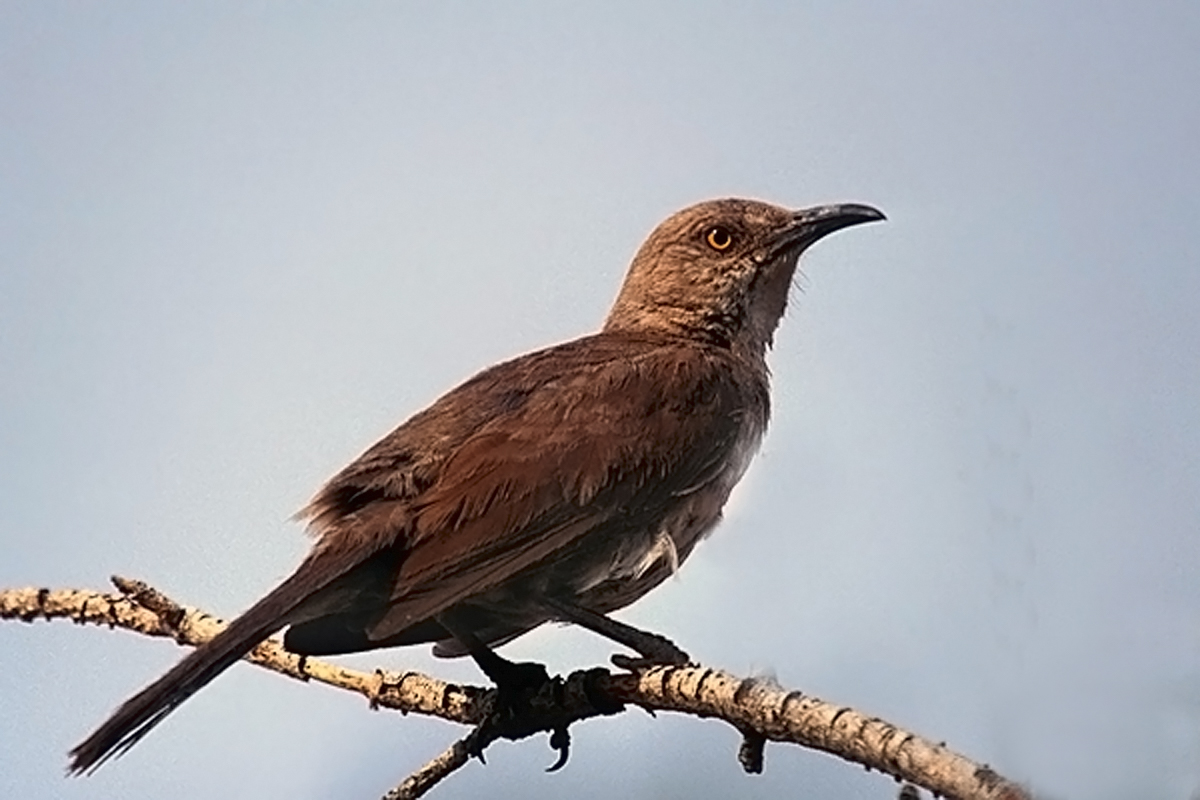
Spring’s Music: Learning to Identify, and Imitate, West Texas Birdsong
By Andrew Stuart
It’s a curious thing to say about creatures that are in fact dinosaurs, and have endured for tens of millions of years, but birds are having a moment. Birding has a growing number of young practitioners. In city and town, it’s an accessible way to connect to nature.
Birders often keep a list of the birds they’ve seen. But there are less formal ways of appreciation. There’s a specific pleasure in birdsong – and in recognizing the calls of the birds that surround us.
A long-time park ranger, Mark Kirtley has led visitor programs at Big Bend on animal sounds – including identifying and imitating birdcalls.
The curve-billed thrasher has been described as the “default desert bird.” It favors cacti – cholla in particular – for nesting. Its call is a quick double-whistle.
But when spring arrives, its song – a series of chirps, beeps and scraps of melody – can be heard across West Texas.
“It’s so fun to listen to a curve-billed thrasher sing,” Kirtley said. “They usually incorporate their basic call – whit-wheet, whit-wheet – into their song, but they’ll go on and on. One of the best treats of being in the desert, like Big Bend, in the springtime is to hear a curve-billed thrasher sing.”
Kirtley is adept at imitating birds. But his programs aren’t performances. He invites visitors to attempt animal sounds themselves.
“I’ve noticed that visitors in park service programs, they just love to make noises,” he said. “It’s so wonderful, it’s so easy to get them to do it. You don’t have to whistle, you can coo like a duck – coo, coo – and everybody can do that. Or you can hoot like an owl – hoot, hoot.”
But for bird sounds, whistling is the key. Kirtley identifies basic features. Is the sound “downslurred” or “upslurred”? He contrasts the poorwill – which chants its name through West Texas summer nights – with the verdin, a tiny forager in desert scrub.
“For instance, the nighttime call of a poorwill, both notes are downslurred,” Kirtley said, imitating the poorwill’s call, and then the verdin’s. “On the other hand, other birds, like the verdin – both of those notes are rather upslurred. If I make that distinction in my mind when I hear something, that reminds me of the sound – and even the feeling of the sound – that helps me to remember and maybe even helps me relate a little to the bird.”
Kirtley also distinguishes between clear and raspy, or trilled, notes.
“For a person who wants to try to imitate a raspy note, it’s good to first learn how to whistle, and then learn how to inhale whistle,” he said. “If you can do that and slurp at the same time, so you have to have a lot of water in your mouth to do this, then you can get that trill. Like for a Say’s phoebe, it’s clear, it’s clear and it’s downslurred. Whereas, like for an ash-throated flycatcher, it’s downslurred but it’s buzzy, it’s trilled, it’s raspy.”
Mnemonics can be helpful. The western meadowlark is a year-round resident here. In spring, its sweet melody sounds across plains and deserts.
A visitor told Kirtley she remembers the song with the words, “Salt Lake City is a pretty little town.”
Birdsong remains mysterious. Basic calls seem to be “hard-wired,” like a human child is born able to cry or scream. But song is more like language – young birds learn it from their elders. Among species, there are regional birdsong “dialects.”
In most species, males do the singing. Song is almost certainly a courtship act – through which males attract mates, and also claim territory, warning off other males. But males of the same species have been observed singing together. And birds continue to sing after they’ve paired and nested.
Kirtley said it’s physically impossible to truly reproduce birdsong. Birds have two-sided voice boxes, and many use them independently, creating counterpoint in a single voice. Learning birdsong is ultimately about an emotional connection.
“I sometimes wonder, why do people like to imitate nature sounds?” Kirtley said. “And I suspect it might have something to do with the idea of empathy.”
Nature Notes is supported by the Shield-Ayres Foundation and produced by Marfa Public Radio with the Sibley Nature Center. The program can be heard each Tuesday and Thursday, at 7:45 a.m. and 4:45 p.m., Central time, on KRTS Marfa, 93.5 FM, and KXWT Odessa/Midland, 91.3 FM. This episode was written by Andrew Stuart.












